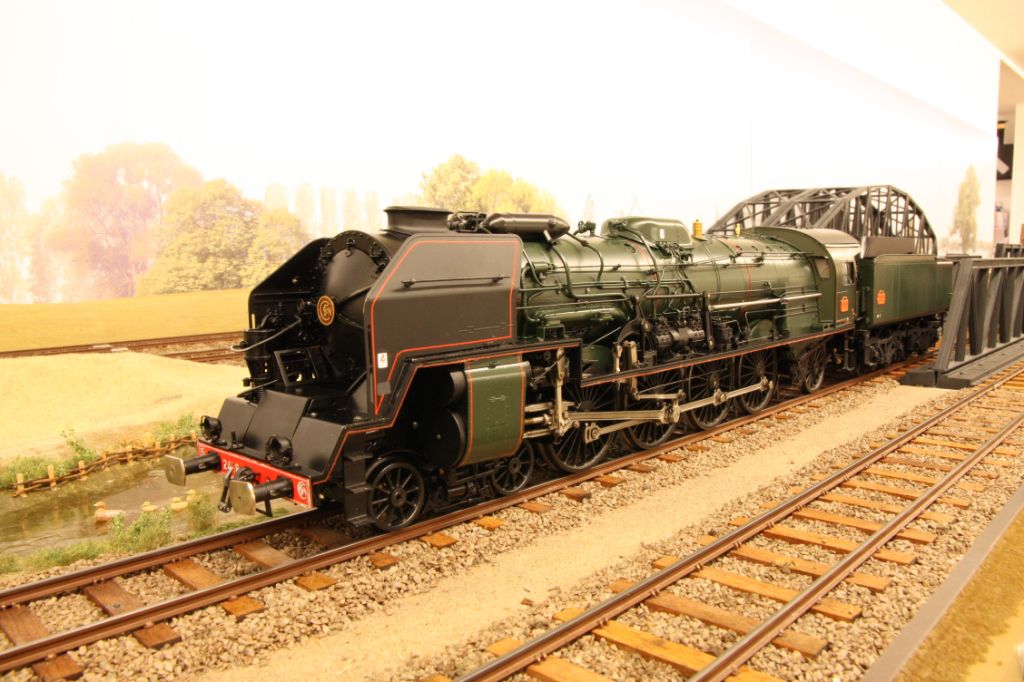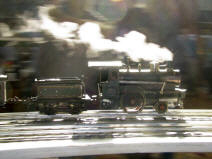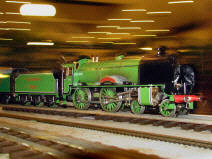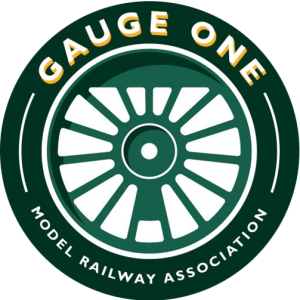Gauge One requires a track gauge of 1¾ inches (44.45mm) which is generally referred to as 45mm. In practice this means Gauge One models are from one to two feet in length (300mm to 600mm); 50% longer than O gauge models and 50% shorter than “3 ½ inch”. This in-between position means the hobby is influenced by both model railways and model engineering; at its best it takes the concern for prototypical system accuracy of the former and the authenticity of the latter.
 Traditionally, enjoying the hobby of model railways means taking pleasure in the construction of a working diorama: either a scale replica of a real railway or a creation of the imagination. To this end, participants lay lines, adapt or scratchbuild models, and construct scenery as well as operate their layout.
Traditionally, enjoying the hobby of model railways means taking pleasure in the construction of a working diorama: either a scale replica of a real railway or a creation of the imagination. To this end, participants lay lines, adapt or scratchbuild models, and construct scenery as well as operate their layout.
The generous model proportions of Gauge One compared to N, OO/HO and O gauges requires a different approach. Space is usually at a premium, especially for an indoor continuous loop to suit live steam. The usual minimum radius is 10 feet (3 metres), although be assured that many models will make it round a 2 metre radius and note both radii are very tight by full-size standards. However, when viewed from the inside of a tight curve as is usual, the appearance is surprisingly palatable and the absolute distances involved serve to somehow soften the effect. Line length varies from around 20 metres up to an astonishing 300 metres in one well known garden which features gentle curves with radii of 20 feet (6m) and above.
 Trains are generally run at table height rather than at ground level and on that premise there are two schools of thought with respect to the look of the line. Some prefer “Track” meaning bare sleepers on an unfinished surface such as felt-covered plywood which is then held up by scaffolding poles. Others choose a “Ladies Line”, in which trains pass over support- hiding hedges, glide over elegant bridges and run atop grassy embankments; all combined with suitably sized plants such as dwarf fir trees or alpine flowers. When effected judiciously, it’s a delight.
Trains are generally run at table height rather than at ground level and on that premise there are two schools of thought with respect to the look of the line. Some prefer “Track” meaning bare sleepers on an unfinished surface such as felt-covered plywood which is then held up by scaffolding poles. Others choose a “Ladies Line”, in which trains pass over support- hiding hedges, glide over elegant bridges and run atop grassy embankments; all combined with suitably sized plants such as dwarf fir trees or alpine flowers. When effected judiciously, it’s a delight.
Ready-made Gauge One track including points and crossovers is available from many suppliers, while numbers of Newsletter and Journal articles have been written on line construction methods. Lineside structures are used sparingly in Gauge One, indeed none at all is realistic; a mile equates to 180 feet or so!
 Railway models form the heart of the pastime. The sheer size of models means modelling form and function is the norm. Many locomotives, particular models of recent origin, show superb exterior detail, while genuinely steam-powered cranks, rodding and valves furnish some engines with additional integrity. Open the hot-to-touch blower and steam gushes from the chimney; leave her waiting and the safety valve fizzes, ease open the regulator and with a hiss and a chuff the pistons push the rods which turn her cranks which turn her wheels!
Railway models form the heart of the pastime. The sheer size of models means modelling form and function is the norm. Many locomotives, particular models of recent origin, show superb exterior detail, while genuinely steam-powered cranks, rodding and valves furnish some engines with additional integrity. Open the hot-to-touch blower and steam gushes from the chimney; leave her waiting and the safety valve fizzes, ease open the regulator and with a hiss and a chuff the pistons push the rods which turn her cranks which turn her wheels!

A surprisingly large selection is available new and, for the patient, secondhand. The last decade has seen existing manufacturers such as: Aster, Barratt, J&M, the Finescale Locomotive Co and Peter Rogers added to by newer firms such as Accucraft, Finescale Brass, Northern Fine Scale, Golden Age and the Gauge 1 Model Co. Inevitably, marques and models vary as to size, complexity, price and arguably, quality. Compare the exciting entry-level Accucraft B4 to the magnificent new Aster 241P, for example.
Reading this, you might think that the way to Gauge One “Cooldom” is to invest the kids’ inheritance in some Gauge One RTR “bling”. Indeed, this will guarantee popularity at the trade-supported AGM and Spring Meeting. Away from these venues, it’s not that easy as for the most part standing in Gauge One is obtained from scratch and kit-built creations as well as adapting factory models. Inviting others to your line and skilled driving helps too!
 Tenmille and Wagon and Carriage have a large range of kits and inevitably there are a host of small suppliers such as Just the Ticket, Wallsall Model Industries. Slaters Plastikard and Orion. It has to be admitted that compared to O gauge, the range is limited and scratchbuilding is often required complete a train. Choose your materials: plasticard, wood, metal or even paper and then source fiddly bits such as roof ventilators or brake gear from suppliers.
Tenmille and Wagon and Carriage have a large range of kits and inevitably there are a host of small suppliers such as Just the Ticket, Wallsall Model Industries. Slaters Plastikard and Orion. It has to be admitted that compared to O gauge, the range is limited and scratchbuilding is often required complete a train. Choose your materials: plasticard, wood, metal or even paper and then source fiddly bits such as roof ventilators or brake gear from suppliers.
 Building live steam locomotives is both a science and an art. Fortunately the Association has several publications for sale on this topic, with parts for the Project, Dee and now ARMIG available from third party suppliers. If you have not done this before then you would be well advised to make acquaintance, via G1MRA, of an experienced builder to guide you. Alternatively, purchase an Aster kit or for the more ambitious, a Barrett or Keith Cousins kit, where the parts have been made for you.
Building live steam locomotives is both a science and an art. Fortunately the Association has several publications for sale on this topic, with parts for the Project, Dee and now ARMIG available from third party suppliers. If you have not done this before then you would be well advised to make acquaintance, via G1MRA, of an experienced builder to guide you. Alternatively, purchase an Aster kit or for the more ambitious, a Barrett or Keith Cousins kit, where the parts have been made for you.
 The secondhand route should not be forgotten, dealers such as Wagon and Carriage, Rushford Barn Models and TMS Models carry a fair range. Auction houses specialising toy sales are worth a visit: Vectis, Specialist Auction Services as well as regional houses (often listed on www.the-saleroom.com) and not forgetting that armchair modelling favourite ebay; check out Modellbau/Modelleisenbahn/Spur 1, on ebay.de in particular. Be warned: minor fettling to an all-out re-build may be needed.
The secondhand route should not be forgotten, dealers such as Wagon and Carriage, Rushford Barn Models and TMS Models carry a fair range. Auction houses specialising toy sales are worth a visit: Vectis, Specialist Auction Services as well as regional houses (often listed on www.the-saleroom.com) and not forgetting that armchair modelling favourite ebay; check out Modellbau/Modelleisenbahn/Spur 1, on ebay.de in particular. Be warned: minor fettling to an all-out re-build may be needed.
Get-To-gethers
 The ever-present Gauge One event is the Get-To-gether (GTG). Traditionally held in a private garden, groups of two to 60 members gather to play trains and advise others how to play trains. Operating live steam demands attention from drivers, particularly for the novice, but as normally only two trains are running at any one time, there is plenty of time for non-drivers to chat and relax. Electric locomotives have the advantage of quick turnaround and high availability and so are often run in the gaps between live steam locos.
The ever-present Gauge One event is the Get-To-gether (GTG). Traditionally held in a private garden, groups of two to 60 members gather to play trains and advise others how to play trains. Operating live steam demands attention from drivers, particularly for the novice, but as normally only two trains are running at any one time, there is plenty of time for non-drivers to chat and relax. Electric locomotives have the advantage of quick turnaround and high availability and so are often run in the gaps between live steam locos.
Mutually owned or managed tracks are a recent trend and can provide the resources to overcome this problem. Many members, including the writer at this point in time, do not possess a track at home, but this is not the obstacle it might seem as there are plenty of individuals delighted to have others come to them. That said some areas benefit from more activity than others.
The Vintage Group members acquire and run engines that usually date from before WWII. Fortunately new Gauge One tinplate track is still manufactured so their trains run like clockwork.
Gauge One Internationally
Inevitably gauge one is parochial; regionalism rules. So at a typical UK event in the south-east, you will see lots of “Southern” post-grouping stock; one or two European locos and rarely a US outline loco. For some unknown reason, lovers of copper-topped chimneys are all over the place.

Providentially, Gauge One manufacturers have built models of many different countries prototypes: France, Germany, Japan and the US in the particular. This is helpful for those who find the prospect of building a model like the SP Cab Forward* daunting.
There are members groups in the US, Canada, Australia, NZ, Denmark, Germany, Switzerland and it’s an outrage that there is only one in France! In addition there are many individuals in the UK with an overseas modelling interest, even Java for example!
The History of Gauge One

 Volumes were cottage industry low; the late Count Coluzzi of Fulgurex fame once said his partnership with Aster had built more locos than all the old manufacturers put together. Short production runs and one-offs meant models were expensive and imbued with the craft skills beloved by the Arts and Crafts movement and its collectors.
Volumes were cottage industry low; the late Count Coluzzi of Fulgurex fame once said his partnership with Aster had built more locos than all the old manufacturers put together. Short production runs and one-offs meant models were expensive and imbued with the craft skills beloved by the Arts and Crafts movement and its collectors.
In the Inter-war years, O Gauge took off, then OO/HO became dominant. Gauge One was kept going by a keen group of enthusiasts, some of whom founded the Gauge One Model Railway Association in 1947.
 The 1970’s brought the shocks of oil, inflation and, in Gauge One, Aster. The Japanese firm stunned the bucolic UK garden-rail scene with an extraordinary production run of 2000 School’s class 1/32nd scale live steam locomotives! For Aster, it was a necessary diversification away mechanical adding machines, for Gauge One, it was a bolt from the blue.
The 1970’s brought the shocks of oil, inflation and, in Gauge One, Aster. The Japanese firm stunned the bucolic UK garden-rail scene with an extraordinary production run of 2000 School’s class 1/32nd scale live steam locomotives! For Aster, it was a necessary diversification away mechanical adding machines, for Gauge One, it was a bolt from the blue.
With a new market of locomotive owners to cater for, commercial rolling stock offerings blossomed. Tenmille, Wagon and Carriage and especially J&M were key to this growth. It appears that the last twenty years have seen a Golden Age in terms of the range of the product available. Accucraft in particular have made a big splash with a range of mostly US outline models. Interestingly, the typical commercial model now has more detail than the typical commercial model of thirty to forty years ago.
 Those with ability in model engineering and modelling stock continued to fill out the roster at GTG’s with lovingly scratchbuilt gems. These were and are a treat for the visitor. Models incorporated features including: slip coaches, block signalling, live diesel, coal firing, axle pumps, working leaf springs, radio control, on board speed control, water level detectors and even fully automated driving to take the burden out of climbing gentle gradients on an oval.
Those with ability in model engineering and modelling stock continued to fill out the roster at GTG’s with lovingly scratchbuilt gems. These were and are a treat for the visitor. Models incorporated features including: slip coaches, block signalling, live diesel, coal firing, axle pumps, working leaf springs, radio control, on board speed control, water level detectors and even fully automated driving to take the burden out of climbing gentle gradients on an oval.
Well there you have it, a description of Gauge One in around 1600 words. Yet there is so much more to it than that, indeed a typical Newsletter and Journal carries upwards of 30,000 words! If you wish to know more, then please click on the membership page and join the family.
* By the way, a good way of losing friends and alienating people is to show up at a UK GTG and launch your US outline articulated loco without telling your opposite number on the inner track. Clearances on UK garden lines tend to be tight for such big locos and no-one wants the sides of their stuff ploughed by a twenty kilo monster!

